Let me start this product review by saying that I do not like writing product reviews. In fact, I would go as far as to say that I loathe writing product reviews. Writing product reviews is an awkward process, companies send you a product hoping that you will fall in love with it and burst forth with glowing prose that motivates anyone that reads the review to rush out and turn their credit cards to ash in an eruption of purchasing activity. This situation can make reviewers feel pressure to like or enjoy a company’s product because—well, this company did send you something—and who doesn’t like to get things? Conversely, there is also a pressure to not give a product a good review in order to maintain one’s product reviewing “street cred” (this sort of street cred is just above the street cred for proper tying of a bow tie and a masterful knowledge of the full canon of the Facts of Life series) because writing a negative review is somehow seen as being more truthful. Every time I write a product review, I feel the pull of both of these opposing poles. Will the company who has sent me stuff be upset if I say their product is garbage brought to life? Will I be called a sell out if I heap praise upon a substandard product? There’s no telling what the reaction to my review will be, so I will simply forge ahead and record what I have discovered, and let the chips fall where they may.
Unboxing
This is another thing I find annoying about the current state of product reviews. The concept that taking pictures of a product while you remove it from the packaging is somehow vital to the reviewing process. It isn’t. The unboxing of a product is to the efficacy of the product as the shell of the egg is to the tastiness of the omelette, remotely related but not likely to have any real effect because it ends up in the trash. That being said, Zwift is an app downloaded to my iPad, so the unboxing was a push of an App Store button from my hyper-critical finger. All in all, it was a pretty uneventful unboxing. (In the spirit of full disclosure, Zwift was so excited to have me review their iOS app that they sent me a Wahoo Kickr to use with their app. I really should’ve taken pictures of the unboxing process for that product, but I am a grown up.)
The Zwift app requires iOS 9.0 or later, and is comparable with iPhone 5s and above, and iPad Airs and above, if you want more detailed information, find another reviewer or go here. My iPad is an Air and is running iOS 10.1.1. Downloading the app was painfully easy.
Set Up and Pairing
I have never been a user of the Zwift desktop platform (I don’t have a laptop, and my desktop computer is poorly placed and far too valuable to pant and sweat in front of), so I used the app for set up and pairing. (I did eventually download the desktop version of Zwift because changing some settings—like weight and ftp—was easier with a mouse and keyboard. Thankfully, all the changes are updated everywhere—if you make a change on the app, it’s on the desktop version and vice versa.) One of the strange aspects of the app is that you have to start a ride to change ANY of your settings—even silly ones like the color of your hair—and then you have to delete that ride, lest you fill your Strava feed with 45 zero mile “I’m thinking more of a frosted tips look” rides.

But lets not get too far ahead of ourselves, first, we’ll open the app. The greeting screen shows your user name and a button to change users and is accompanied by background music that I assume is the b-side of the lost KC and the Sunshine Band follow-up to Boogie Shoes. Click on your user name and the pairing process begins. Since I am using a Kickr with a cadence thingy, this process is very easy. (Technical aside, I have been using a 4iiii heart rate monitor for my indoor rides, as they are rumored to be both ANT+ and Bluetooth, but my iPad is only occasionally interested in connecting to it. This is not a Zwift issue. I bring it up because I like to complain.) Once your trainer is paired, click the “let’s go” button and you’re ready to start your ride. (There’s also a “just watch” button, which I assume is for coaches, stalkers or the desperately lonely.)
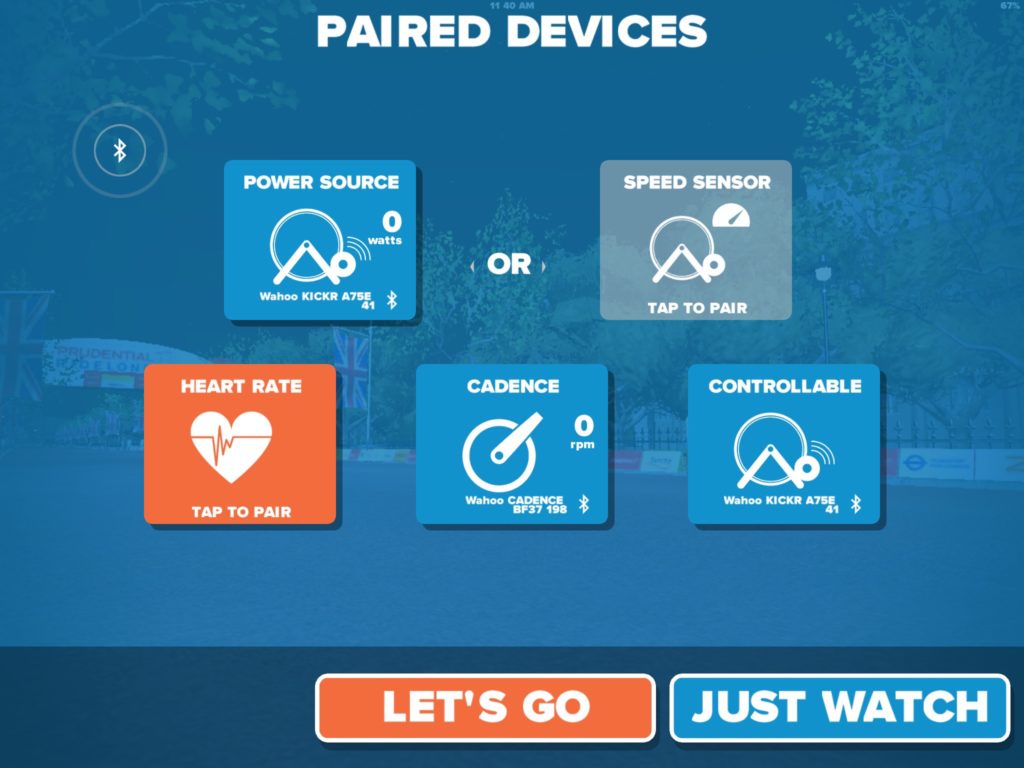
Everything but heart rate, I’m an idiot.
After pairing, you are on the start screen, where you choose to just ride or select a specific workout and where you select the route you’d like to ride. You can also join other riders on this screen (and feel the thrill of “meeting up” with people you know—of course, you aren’t actually “meeting up” with anyone—you’re seeing them on screen, but it feels like it). Select “ride” and you are put out on the course.
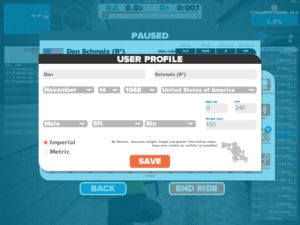
I really weigh this much, NOT A LIE!!
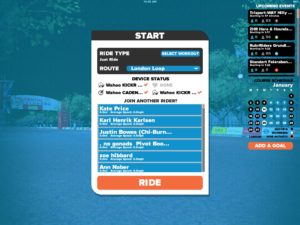
This is where the magic begins.
Before pedaling, you should make sure all of your user profile settings are correct via the menu button. Zwift calculates your speed and watts per kilogram based on your height and weight, so any inaccuracies here will alter your speed in the world of Zwift (AND GIVING THE INCORRECT WEIGHT IS TOTALLY CHEATING, BTW). You can alter app settings such as sound, language, units of measurement, trainer difficulty (for those trainers that do that) and others here. I turn off the sound here, because I find almost all computer noises to pointless and distracting.
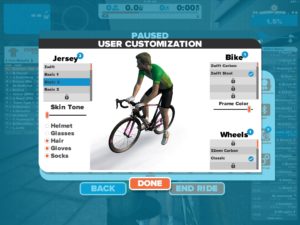
Frosted tips, oddly not an option.
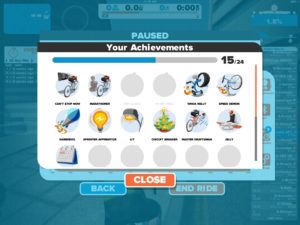
Ignore this if you’re not twelve.
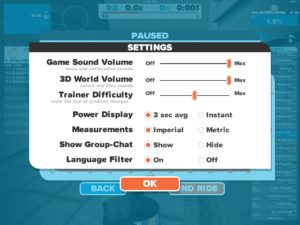
Obligatory setting screen shot
You can also hit the “customize”
button here and change your jersey, hair color, bike, wheels, skin tone, helmet (or lack of one—I ride digitally without a helmet, because I am an imaginary daredevil), glasses, gloves and socks. You can earn different bikes, jerseys, wheels and other stuff which might appeal to you if you’re a twelve year old. I am not, so I just set this configuration up once and left it alone.
There’s also an “achievements” button on the menu screen, which I ignore completely also, because again, not twelve.
Riding Experience
I will admit that I was more than a little thrilled the first time I made it to an actual course with other actual (virtual) people, and I pedaled my bike on my trainer and my virtual self stepped off the curb and pedaled along. I was riding! Or simulating riding, more accurately. My wattage and RPMs were showing in the top left hand corner of the screen and I had speed, distance and time elapsed showing in the center top of my screen. Course elevation was in the top right column, with a list of nearby riders below, with each rider’s gap, distance ridden and watts per kilogram shown. As I pedaled along, I soon learned one of the most important lessons of Zwift, WATTS PER KILOGRAM IS ALL THAT MATTERS!
An aside about the importance of watts per kilogram in Zwift
Seriously, w/kg is all that matters in the world of Zwift. It determines how fast you will go on any given virtual terrain. Naturally w/kg also determines how fast you’ll go in the real world, but knowing the w/kg of every passing rider in Zwift world really presses the idea home. There are group rides on Zwift that describe their proposed intensity in w/kg beforehand. (“Hey! I thought this was a 3.5 w/kg ride, why are we going 4 w/kg!”, me, on a ride.) This w/kg fixation also creates scenarios where you develop w/kg envy—as in, you catch yourself ogling another rider’s 5.1 w/kg pace as they speed past you while you tell yourself that they are obviously underreporting their weight to fudge their numbers. Jerks.

Closing the gap, the only thing that matters.
But weight watching aside, Zwift really does a great job of mimicking the pedal feel of elevation and drafting. By altering the resistance on my Kickr via Bluetooth witchcraft, I get the sensations of climbing, descending and drafting. (Granted I do not get the sensations of atmospheric conditions, balancing, cornering, bumps or wind resistance, but when considering my indoor alternative would be watching my sweat pool beneath my trainer, I’d say it’s a fair trade off.) When approaching other riders, Zwift encourages you to “close the gap” to the rider ahead of you, and shows you a neat little graphic of how far you need to go to feel the sweet second of release when you hit the draft of a rider in front of you. And if you’re on a crowded course, you can obsessively bounce from wheel to wheel as you cruise the world of Zwift for wheels to draft.
While this sort of group cruising can be fun, you can also use Zwift as an interval, group ride or race platform. Zwift comes preloaded with a selection of workouts to choose from. You can choose your workout based on the amount of time you have to ride, intensity or you can even create your own workout via a drop and drop system (I created one myself, and I’m an idiot, so you should have no problem creating one also). You just hit the workout button on the start screen and choose which way you’d like to hurt yourself.
The Workout Experience
I’ve done a few workouts on Zwift now, and they’re a pretty effective way to get that sweet, sweet pain that every bike racer seems to be looking for. When you get to the start screen, you hit the “workout” button and then you can chose from a menu of workouts. The workouts are classified according to the amount of time you have, whether you are on a specific plan or they can be custom workouts you’ve made or have received from your coach. You select the workout you want to complete, select a route and you are ready to be immolated. When you are shown in the world of Zwift during a workout a “workout shield” appears in front of your face so that other riders know that you aren’t necessarily being antisocial, you’re just riding according to your own pace.

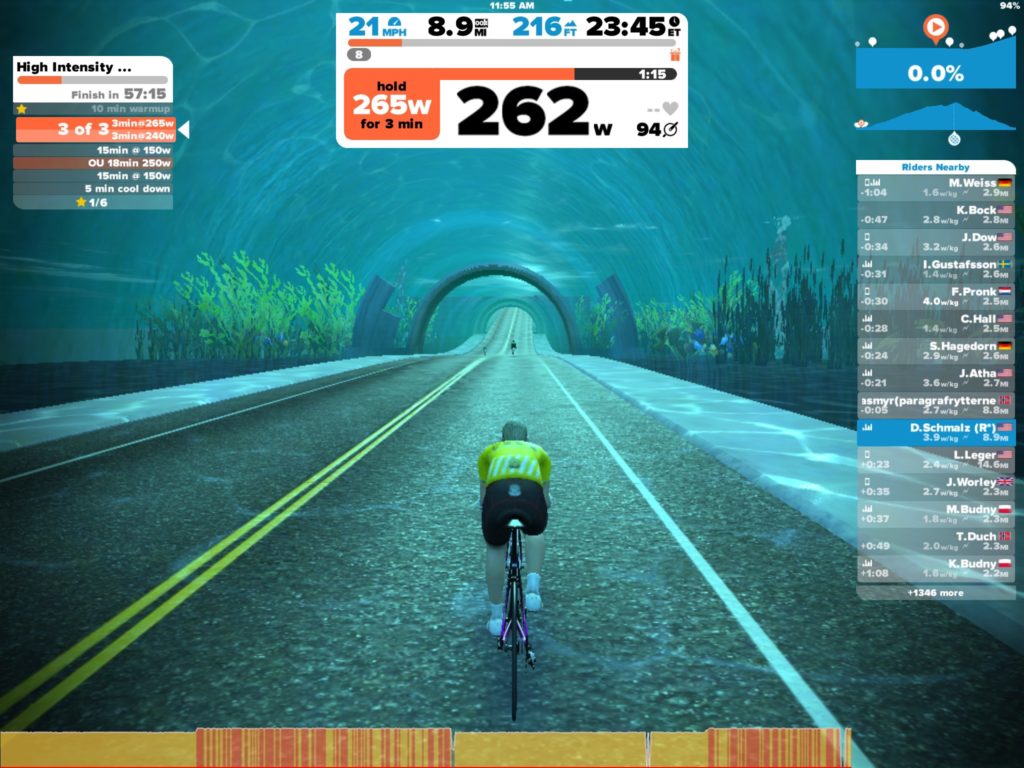
Pain, underwater. Sharp-eyed readers will also note I changed my jersey, and you can never get the time you spent noticing that back.
The interface for a workout differs from an interface for ride. On the left is the listing of intervals that need to be completed, think of it as a menu of pain (on the bright side, you get a little star for each interval completed, so it’s like kindergarten all over again). The middle top menu becomes the section that you will be focusing on, as it tells you what to do. It gives you the target wattage for the interval and displays the wattage you’re putting out, along with a countdown timer for the duration of the interval. During intervals, these three data points are ALL THAT MATTERS IN YOUR LIFE AT THAT MOMENT. Hit the numbers, and all is well, fall below and Zwift tell you that you need add “more power”.
Zwift switches to ergonometer mode during intervals. There’s no trainer reaction to terrain, as the software seeks to make the resistance more steady rather than replicate the differences in elevation. And this is good, it mean less shifting and fiddling about. You just get in a gear and pedal. But I will recommend that you shift your gears after an interval, because if you don’t, Zwift will reduce the resistance to your trainer, leaving you in the gear that you do your interval in for your recovery. And then, when you go for another interval, you will want to shift up a gear, which means you eventually creep down your cog during intervals and find yourself in the 11 cog trying to do 110 rpm to hit your target wattage. This is probably just something that happened to me, but I definitely recommend shifting when going from interval to recovery. (During my intervals, it seemed like I was never quite able to hit my wattage numbers exactly. It always seemed like I was 5 or 3 watts under my target number. Even when I increased my cadence, my wattage number never seemed to rise. Is Zwift messing with me? It is, right? It can’t be me. I’m not the problem, no way.) Ghost wattage aside, doing intervals on Zwift is exactly like doing intervals in the world—it’s a revolting and hurtful experience—except you don’t have to stop for traffic lights or worry about coasting downhill.
The group ride experience
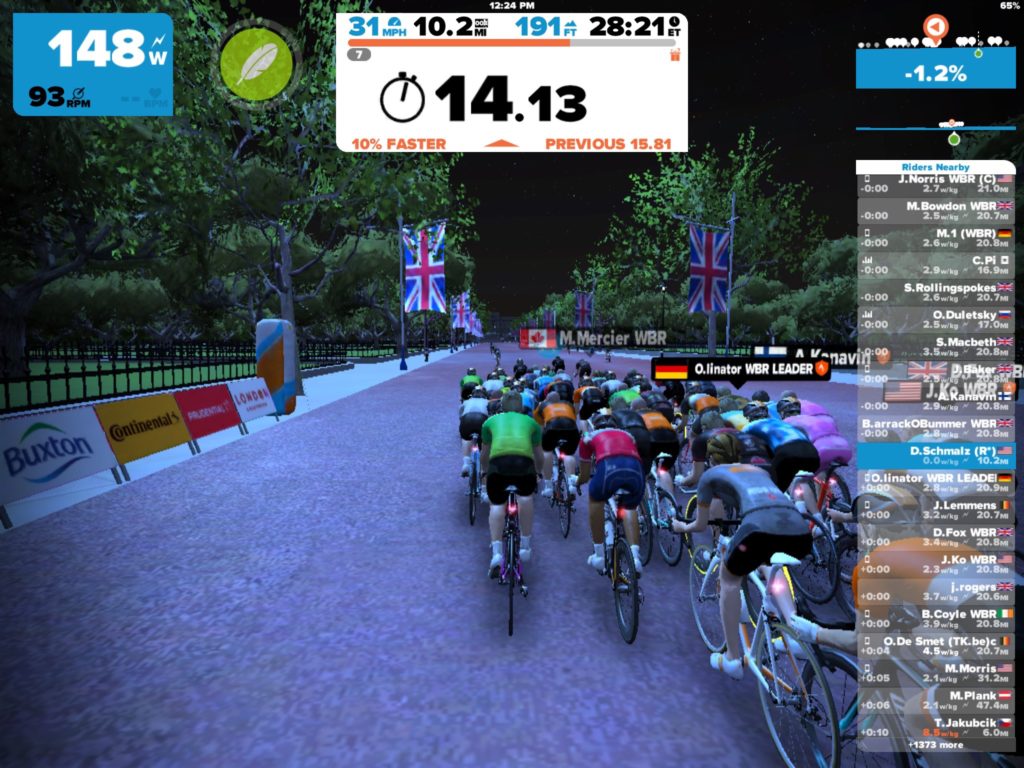
Who are all of these people?
In order to expand my experience of the world of Zwift, I joined a group ride that was organized by my teammate Kim. We were to meet at 7:15 am on a Saturday morning, and we planned on riding at an endurance pace on the London Loop. I “showed up” a little early and found out that when you show up to a ride early, Zwift put you on a virtual trainer at the start line. So I found myself riding a trainer while watching myself on a screen riding a trainer, then I stared at a spinning top; I came out of a dream and the group ride started.
What I immediately found out about the group ride was that it was a lot like almost any other group ride I’ve ever taken part in. We started out WAY too fast, we went WAY too hard, and I eventually complained about the pace. Just like a ride in real life. And this is how you know that Zwift mimics real life—because you’re able to do the same annoying things you can do in real life.
Some minor issues I’ve discovered
The app version of Zwift automatically adds random screenshots from your ride to your Strava profile. The pictures fill up your Strava profile and make people think that you’re an android (you can set the desktop version of Zwift to not upload photos automatically, but the app doesn’t seem to do have the option to opt out).
Zwift loves battery! A two hour ride on Zwift takes my battery from 100% to 47% (sanity levels actually remain constant, however). And even if my iPad is plugged in, the app still drains the battery at a rate faster than the recharge. So, you can find yourself in the situation I did a few days ago, where you’re at 1% battery and have to decide whether to stop a ride short, or risk losing your precious, precious ride data.
THE MILEAGE AND ELEVATION NUMBERS ARE A LIE. Seriously, I did an easy Zwift ride at an average wattage of 152 with an average heart rate of 121 and my average speed was 21.6 MPH. Let me repeat that, twenty-one-point-six. That average speed is simply preposterous, but the only real victim in this case is my overinflated Strava numbers, so it’s not the end of the world.
The Zwift Racing Experience
I’ve done a few races on Zwift now and I can say with authority that the experience is exhausting, confusing and exasperating—so, just like a real race really. Zwift races are held on the same course as the Zwift rides and workouts, so when you’re racing theres usually about 2,000 other people sharing the course you are riding on. This is good for buzzing riders that are plodding along at 2.2 w/kg (losers), but it can be very confusing when you’re trying to figure out the gap to the group ahead of you—it’s like racing in a pack through an MS150 ride full of Agents from the Matrix movies—you have no idea who is a friend or who is an enemy, and a lot of them have sunglasses on.
The concept of pretend bike racing in pretend world perplexed me to such a point that I contacted Eric Min, the CEO of Zwift and emailed him until he regretted emailing back, there is the exchange that followed.
schmalz What’s the course that people recommend you digitize the most?
Min It’s either a course they dream about (the French Alps) or it’s their favorite training loop (Central Park, Gimbel’s ride, etc)!
schmalz Any chance we can get the Central Park night ride as a regular route?
Min We had toyed with the idea of Central Park and we have experimented with Richmond, and we’re doing more real courses like London but Watopia, our fantasy island is by far what users want the most.
schmalz I will admit that I really don’t pay much attention to the courses I ride, I’m pretty sure if you placed me on the course in real life I wouldn’t be able to find my way out. I guess a virtual world satisfies riders criteria for challenging terrain. How much effort does it take to create new courses?
Min Then you are a minority. The community goes nuts over more digital pavement. It takes about 4-6 weeks to build an expansion. We just released the volcano expansion and the London one should be coming out in a couple of weeks. We’ll do another expansion to the volcano soon afterwards. We expect a much bigger expansion in Apr.
schmalz I am very much not a video game person, so the course changes have little or no effect on me. I do like the races, but dear Lord, they can be confusing. I have no idea where I am during races. Are there any changes planed for the race format?
Min Pretty soon we’ll introduce a concept of private or closed events and if you’re in those events, you won’t see others in the world but those outside of the events will see you.
schmalz That will really help, I guess having a “closed course” is not an option?
Min We could also do that but I think most people will agree that it’s pretty exciting to see a pack of riders whiz by.
schmalz Getting passed by a pack of racers is a bummer, what’s wrong with these people? I would suggest each racer have a huge orange flag on their bike so we can identify each other. Or maybe racers could glow. These are all such awesome ideas, it feels so good to be redesigning the app.
Min We’ve talked about drones (we don’t like cars) leading the pointy end of a race. We can really have some fun with that one.
schmalz How about a unicorn hologram running in front of the race? (You think I’m kidding about this, but I’m not.)
Min Hilarious. Let your imagination run wild!
schmalz The companies that make trainers must love you guys, are they planning new features for their trainers to make them more “Zwifty”?
Min It’s no secret that Zwift has helped the trainer market. Our partners have told us. We’re hoping that consumers will see more affordable smart trainers in the market. That is the single biggest friction point for most users.
schmalz Playing hardball, I like it. Have you seen many coaches get involved with Zwift?
Min Many coaches and some of them are very creative. I love what David Lipscomb, a NYC coach has done with his CIS coaching business on Zwift. He’s leveraging Zwift, the platform, to help him enhance his coaching services. I think that’s great!
schmalz On a more serious note, how do you respond to the assertion that simulated indoor cycling might actually be damaging to real world cycling, as people ride indoors for safety, and the actual number of outdoor riders decreases, making outdoor cycling seem even more marginalized?
Min I actually think Zwift will encourage more people to try cycling and help existing cyclists stick with cycling. But there is no doubt in my mind that Zwift has raised the bar for when you actually do go outside. I only go out when the circumstances are ideal.
schmalz It will interesting to see if the mostly indoor riders make it outside. I will say Zwift makes me ride MUCH harder indoors (due to being a dumb, competitive bike racer type). What’s your answer to people who say that Zwift mile and elevation numbers aren’t real?
Min They are real in the sense you are working. In fact, you are working much harder indoors than outdoors. I rode outside the other week and you would be surprised at how many zero watts are in your power file. Indoor training is super efficient. You just work the entire time. We believe a whole new category of cycling called eRacing will surface. In many respects, Zwift already has this “underground” virtual racing. Stay tuned. You’ll hear much more about it at the end of this year.
schmalz Uh oh, eRacing feels like it will bring e-cheating. How will you control that?
Min There is a community site called zwiftpower.com that verifies your performance. There is also Zada. Yep, Zwift anti doping authority! But I think the league will be broken out by equipment especially with the introduction of smart bikes, which will be easier to control virtual doping. There may also be an open league, which is like what we have today with Zwift racing. I think the potential is enormous for eRacing and there is no reason why it can’t extend to professional leagues. There will continue to be road racing, cyclocross, track, etc but I see eRacing as another category, which will be vastly more accessible to the masses.
schmalz Weight doping, weight doping, everybody who gets beat on Zwift talks about it. Will there be video weigh-ins?
Min Zwiftpower.com catches weight dopers! You need an active profile on Strava and the data is cross referenced by this group. I also believe that the second generation smart bikes will have a built-in scale so your weight will be measured every second of your ride. But eventually in any finals, you’ll need to show up in person! It will be obvious if you’ve been playing with your weigh!
schmalz What if I wear Spanx? Will you still believe I weight 98 pounds?
Min I actually had to look up Spanx! Let the community do the policing for now. If you have no social networking profile, you won’t be verified.
schmalz When you get down to it, all racing comes down to a level of mutual trust, just like life I suppose. So I guess eRacing is more real than we thought.
Min eRacing is already happening. What exists today is a bit underground but we made a recent announcement about eRacing and was reported in Velonews.
http://www.velonews.com/2017/01/news/zwift-academy-back-2017-now-eracing_428997
schmalz Will there be categories? How about a Iowa natives living in New Jersey over 47 and one half category? That would be nice.
Min Man, that is the beauty with eRacing. It will be so accessible (and affordable) and it’s global from the outset. Maybe we won’t need national federations at all and no affiliation with UCI or the Olympics — just one big international league. There are no borders and we could schedule events every hour.
schmalz I think the last thing we need is an eUCI.
Min You are going to see so many who would never have considered bike racing enter Zwift to race and of course the quickest riders will be experienced bike racers because just like in the real world, there are tactics and team work that can play out even on virtual roads. Two way communication is coming this year which should spice things up (many are already using Skype, FaceTime and other tools). People really geek out on Zwift!
schmalz Yes, yes they do.
The Zwift Phenomenon
Yes, Zwift is a phenomenon. How do I know this? When I talk about Zwift with my bike dork friends, there’s no need for a preamble to describe what Zwift is. They already know. Even if they don’t use the platform, they’ve heard enough about it to know what it is. They may have firmly held notions about what Zwift is doing to riding bikes (I guess they think bikes are being ruined by Zwift? Something is always ruining bikes somehow.), but they know what it is. When I have discussion with riders that I know who use Zwift, the talk always eventually drifts to the one thing that matters WATTS PER KILOGRAM. As in, “This guy was doing 25 w/kg, there was obviously a glitch involved.”; or “The ride was crazy, I was doing 5.5 w/kg and barely hanging on.” or “If I cut off my arm that could raise my w/kg significantly.”
The accuracy and convenience of the world of Zwift is addicting. You can do a ride, workout or race without leaving your home. You then get a complete dataset from these activities that’s uploaded to your Strava account (if you’re into that sort of thing). Your workouts can be perfectly calibrated and executed. It’s like living in West World for bikes. You know you should go outside sometime, but Zwift is just so damn convenient.

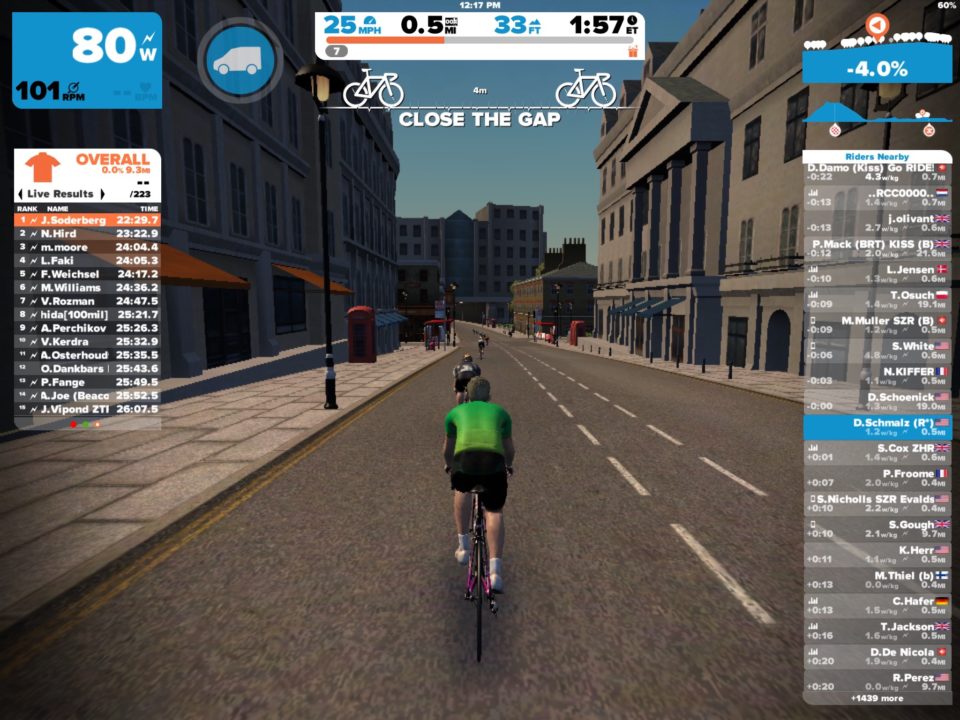

Great review Dan!
Agreed , great review.
Great job as always Dan!
As a long time Zwifter, I found this to be a very accurate and humorous review! Ride on!
“buzzing riders that are plodding along at 2.2 w/kg (losers)”
Pretty douchy
Hahaha Dan, really enjoyed the unicorn humor, good interview as well. Keep it coming. Thanks
Well written. Entertaining and some great exclusives around what we have to look forward to on the platform. Good stuff.
Barely left for irl ride since last march 2015, all because of Zwift
2.2? That’s close to my FTP! That’s what happens when you stop racing in real life and put on 30 KG. I’m doomed
Was made aware of this review via ZwiftCast. Spot on with your observations and some exciting insight from Eric!
fag
2.2 (losers)
For real
I do 2.2 in my sleep.